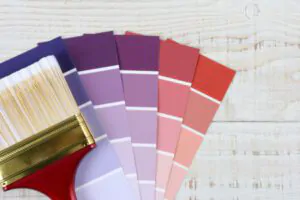Choosing the right interior paint colors is important because it can affect the overall mood, ambiance, and aesthetic of a space. The colors you choose can also impact the perceived size of a room and can influence the way natural and artificial light interacts with the space.
Understanding color theory is going to be helpful when picking paint colors because it can provide a framework for selecting colors that complement each other, create a desired mood or atmosphere, or convey a particular style. Color theory can also help you avoid clashing colors or selecting hues that might look off in certain lighting conditions.
How to choose a wall paint color? Stick around; we’ll show you how color theory can help you.
Color Theory Basics

Color theory is like the Lebron of interior design – it’s sort of a big deal. At its core, color theory is all about understanding the relationships between different colors and how they work together to create an overall look and feel.
Primary, Secondary, and Tertiary
Primary colors are like the parents of the color wheel – red, blue, and yellow. They’re the building blocks of all other colors. By understanding how primary colors work together, you can create an endless variety of colors and shades.
Secondary colors come from mixing primary colors. So, if you mix red and blue, you get purple. Mix blue and yellow, and you get green. You get the idea.
Tertiary colors are made by mixing a primary and a secondary color. For example, red-orange or blue-green.
Warm vs. Cool colors
Warm colors include reds, oranges, and yellows, as well as earthy tones like browns and beiges. These colors tend to create a sense of coziness, intimacy, and energy, making them a popular choice for spaces like living rooms and kitchens. Warm colors are also associated with passion, excitement, and creativity.
On the other hand, cool colors include blues, greens, and purples, as well as gray and black. These colors have a calming effect and can create a sense of serenity, relaxation, and sophistication. Cool colors are often used in bedrooms and bathrooms, as well as spaces where a sense of tranquility is desired.
Take note that warm and cool colors can be used together to create a balanced and harmonious color scheme. For example, a neutral beige or gray can provide a calming backdrop for pops of warm red or orange accents, while a cool blue or green can balance out a warm orange or yellow.
Related Post: Why You Should Paint The Interior Of Your Home During The Winter
Complementary colors and color schemes
Complementary colors are opposite each other on the color wheel (like blue and red or orange and purple), and they create a high-contrast, eye-catching effect.
In addition to complementary color schemes, several other styles of color schemes can be used in interior design. Analogous color schemes involve using colors that are neighboring each other on the color wheel, such as blue, blue-green, and green. Monochromatic color schemes involve using variations of a single color, while triadic color schemes involve using three colors that are evenly spaced throughout the color wheel.
Tips for Choosing Interior Paint Colors

1. Consider the function of the room: The colors you choose should reflect the room’s purpose. For example, warm and energizing colors like red and orange are great for living rooms and kitchens, while cool and calming colors like blue and green are ideal for bedrooms and bathrooms.
2. Take inspiration from your surroundings: Look at the colors and patterns of your furniture, artwork, and décor for inspiration. This can help you create a cohesive and visually appealing color scheme.
3. Test paint swatches: Always test paint swatches in the room you plan to paint. Natural light, artificial light, and the size and shape of the room can all impact how a color appears.
4. Consider the undertones: Every color has undertones, which can be warm or cool. Be sure to choose a color with undertones that complement the other elements in the room.
5. Don’t be afraid to go neutral: Neutral colors like white, beige, and gray can be a great choice for creating a timeless and versatile look. They also provide a clean backdrop for colorful artwork and décor.
6. Get help from professionals: If you’re struggling with how to choose interior paint colors, consider hiring an interior painting contractor. They can provide expert advice and help you choose colors that meet your needs and reflect your style.
Looking for Interior House Painters in Boston?

A visually appealing home interior can substantially impact our well-being and quality of life. When beautiful and well-designed spaces surround us, we tend to feel happier, more relaxed, and more comfortable in our own homes.
If you’ve already got an idea of what colors you’ll go for then it’s time to call in expert home interior painters. At Boston Best Painter, we’ll paint your home professionally at an affordable price. And if you still have no clue what colors to pick, we’ll give you the best advice so you can have a beautiful home interior.
You can give us a call at 781-605-7718, and we would be happy to paint your home’s interior!





